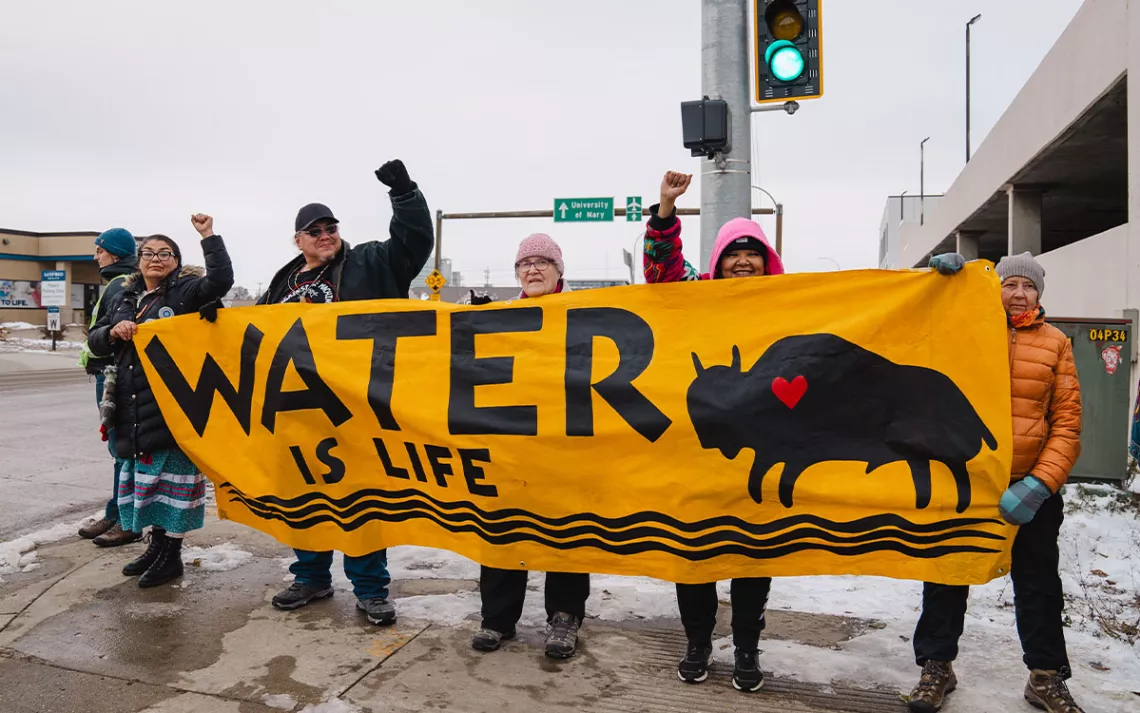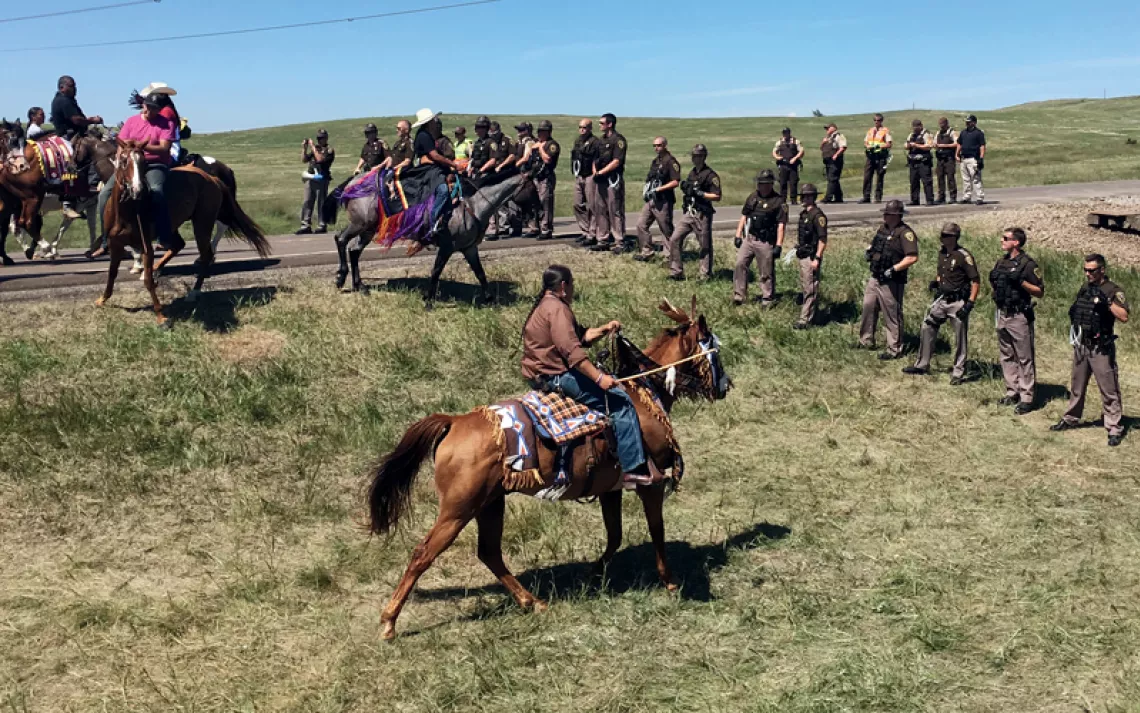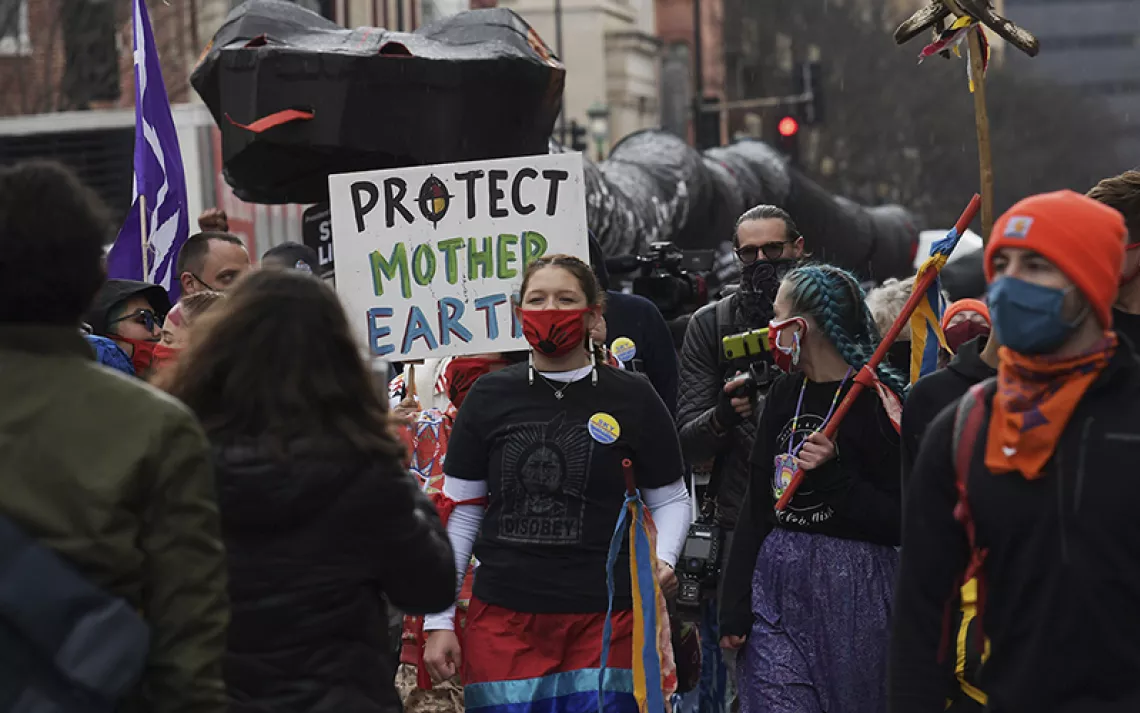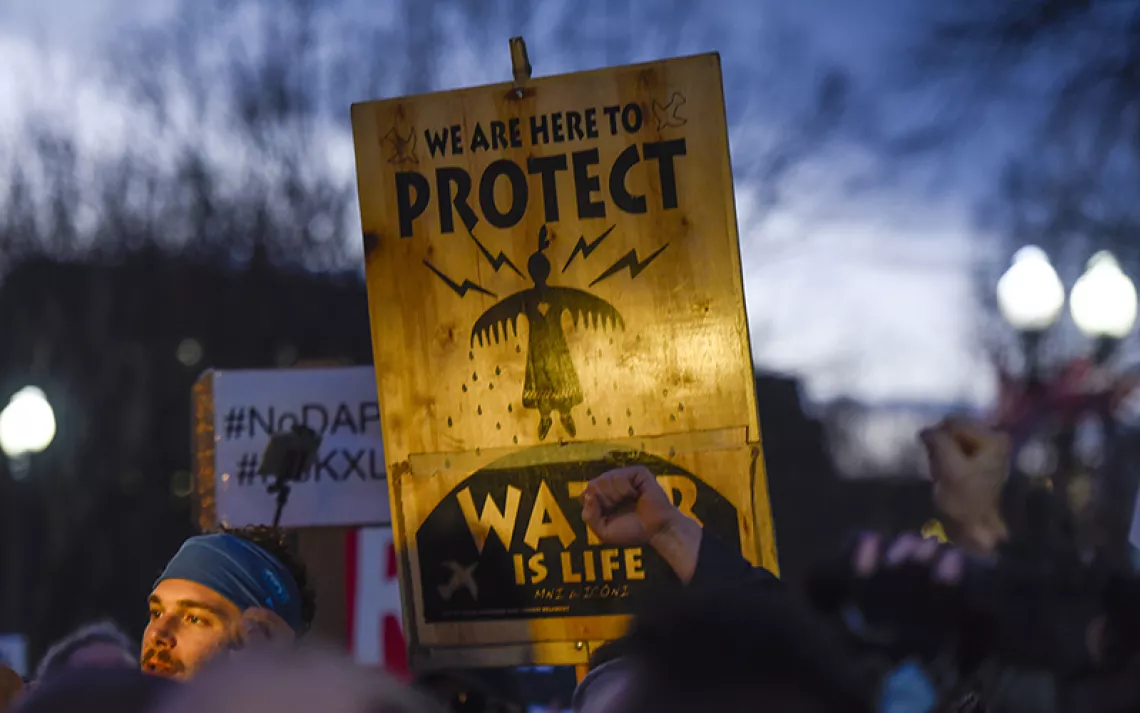A New Hope for Shutting Down the Dakota Access Pipeline
An unusual, after-construction public comment period opens the door for correcting a grave mistake

People rally in solidarity with the Standing Rock grassroots and Cheyenne River Sioux Tribe before a US Army Corps hearing in Bismarck on the Dakota Access Pipeline. | Photo by Devon Young Cupery
Reckless development proposals such as mines, mega-dams, and oil pipelines have a way of coming back from the dead. The controversial Keystone XL Pipeline is a recent and classic example: a zombie project that just wouldn’t die. Now, in North Dakota, environmental groups and Native American tribes are seizing on a rare opportunity to shut down a fossil fuel project that’s already up and running—the fiercely fought Dakota Access Pipeline.
Earlier this month, tribal members and environmentalists gathered in Bismarck, North Dakota, to give public testimony on the draft environmental impact statement for a critical section of the Dakota Access Pipeline. Before the hearing, activists who had traveled by bus from the Twin Cities rallied on the sidewalk with members of the Cheyenne River and Standing Rock Sioux Tribes, which for years have led opposition to the oil pipeline.
“They are illegally operating on my land. I want it to stop for the children,” said Morgan Brings Plenty, digital organizing fellow at the Indigenous Environmental Network and member of the Cheyenne River Sioux Tribe.
Brings Plenty held a memorial banner for four tribal members, including Morgan’s mother, Joye Braun, a leader of the #NODAPL protests who died last year. Throughout the day, activists repeated the phrase mni wiconi—water is life.
The Dakota Access Pipeline transfers Bakken crude oil from North Dakota over 1,100 miles to a terminal in Patoka, Illinois. A one-mile section runs under Lake Oahe, the source of the tribe’s drinking water, a mile north of the Standing Rock reservation.
During the permitting process for DAPL, project owner Energy Transfer Partners rerouted the pipeline away from the towns of Bismarck and Mandan and under Lake Oahe, which is part of the Missouri River—a move the Lakota People’s Law Project calls “textbook environment racism.” An environmental assessment concluded the project would have “no significant impact.”
In spring 2016, tribal members began protesting the pipeline and soon established a small encampment at Standing Rock. Thousands of people from all over the US and Canada eventually joined them, and the Dakota Access protests became a high point of the larger Indigenous sovereignty movement. In late 2016, President Obama halted construction on DAPL and called for a thorough environmental review. Just a month later, a newly inaugurated President Trump reversed the decision. Oil began flowing in June 2017.
The affected tribes never stopped fighting DAPL. The Standing Rock Sioux Tribe, represented by Earthjustice, sued the Army Corps, alleging the agency had rerouted the pipeline without adequate environmental analysis or meaningful tribal consultation. In 2020, a federal judge revoked the permit for an easement under Lake Oahe and ordered the agency to prepare an environmental impact analysis—a very unusual move for a project that is already in operation. Oil has continued to flow, even though Energy Transfer Partners does not hold a valid permit.
Last September, the US Army Corps of Engineers issued the long-awaited draft EIS for the Lake Oahe segment. It evaluates five alternatives: removing the pipeline; abandoning it; granting the easement as is; granting the easement with additional conditions; or constructing a new segment north of Bismarck. The agency has not yet weighed in on which alternative it prefers.
Standing Rock chairwoman Janet Alkire called the process a “sham” in a press release criticizing the EIS. “The oil company’s emergency response plans are inadequate, its safety track record is horrendous, and there’s been a stunning lack of transparency with Standing Rock throughout the environmental review process, including inaccurate characterizations of tribal consultation,” she said.
Tribal and environmental groups, including the Sierra Club, are not just calling for revisions to what they view as a flawed document. They are asking for a complete rejection of the pipeline, arguing that its potential for disastrous spills and contributions to climate change are unacceptable.
To finish the original pipeline, Energy Transfer Partners used a construction technique called horizontal directional drilling to tunnel under Lake Oahe. This section runs just over a mile, making it one of the longest such projects in the world. Critics contend it’s a matter of when, not if, the pipeline will leak, and point to Energy Transfer Partners’ poor track record on other pipelines.
The Federal Energy Regulatory Commission fined the company $40 million after construction on its Rover Pipeline in Ohio contaminated a protected wetland with drilling fluid. In Pennsylvania, the company faced criminal charges after its Mariner East Pipeline illegally released thousands of gallons of drilling fluid into a lake and wetland. DAPL itself has leaked at least five times since it was commissioned.
Critics allege that the draft EIS underestimates the likelihood of a spill and relies on overall statistics on spills and accidents rather than considering Energy Transfer Partners’ dubious record.

Make every day an Earth Day
Get articles like this one sent directly to your inbox.
With this action you affirm you want to receive Sierra Club communications and may vote on policy designated by the Sierra Club Board.
“The Corps has consistently dismissed facts related to Energy Transfer’s safety performance, preferring to gauge DAPL’s risk based upon a flawed analysis of generic statistics of crude oil pipelines,” said Dan Crow Ghost of IEN. “It’s outrageous that the federal government would allow a pipeline facing charges and millions in fines in several states for pipeline safety-related crimes and violations to operate just upstream from our water supply.”
Energy Transfer Partners has not commented on the Dakota Access Pipeline in more than three years, since the federal court ruling calling for a new EIS.
The Army Corps hired Energy Resources Management, a member of the American Petroleum Institute, to draft the EIS. ERM also conducted the review for the controversial Keystone XL Pipeline, which the Biden administration torpedoed.
The EIS also uses a narrow lens to assess the pipeline’s climate impacts, opponents say, as it only focused on the greenhouse gas emissions associated with construction in each of the five alternatives. Michele Bustamante, staff scientist for the Nature Program at Natural Resources Defense Council, calls the climate analysis “structurally flawed,” in part because the document suggests that even if DAPL were shut down completely, Bakken oil would make its way to market another way, or that other fossil fuel sources would make up for it.
“You can’t just say, well, if not for this project it would just happen elsewhere,” Bustamante said. “The argument that it wouldn’t make a difference is a bit absurd and a strategy that we’ve seen time and again.” If we’re serious about navigating to a safer climate, she added, the Army Corps should seriously consider DAPL’s cumulative emissions. The Sierra Club has for years called for President Biden to shut down DAPL, pointing out that the pipeline is incompatible with the administration’s climate goals and commitments to tribal sovereignty.
Alikire and other Standing Rock leaders say the Army Corps is deliberately excluding and minimizing indigenous voices. On the first day of the public hearing, commenters were asked to record their comments privately in a booth with just a stenographer and staff member from the Army Corps present. Eventually, someone produced a megaphone and people began sharing their testimonies and stories with each other in the lobby of the building.
“People spoke about family members who have passed in the past few years and why they’re in this fight, the legacy of harm, and the treaties that aren’t being honored,” said Elizabeth Scrafford, deputy field director for the Sierra Club’s Upper Midwest Region. “You’re with folks who have been part of a deep and powerful movement that feels entrenched in the power against corporate greed and the fight for native sovereignty.”
The most important thing anyone can do to stand with the tribes is submit comments before the December 13 deadline, she added.
“The Army Corps needs to go back and restart this process and really consider the risks to climate and environmental justice,” Scrafford said. “We want this permit to be denied, and the pipeline should be decommissioned once and for all.”
 The Magazine of The Sierra Club
The Magazine of The Sierra Club



